Carbon monoxide poisoning can cause severe injury or even death. Symptoms of carbon monoxide poisoning include nausea and shortness of breath. But CO poisoning is preventable. Buy a carbon monoxide detector for your home and make sure it works. Have fuel-burning appliances checked regularly.
What is carbon monoxide poisoning?
Carbon monoxide (CO) poisoning happens when you breathe in fumes that contain CO. You can get very sick or even die if you breathe high levels of CO for even a few minutes.
What is carbon monoxide?
Carbon monoxide (CO) is a gas produced when gasoline and other fuels burn. It is invisible and colorless. You can’t smell or taste it. CO can build up quickly and is dangerous in high levels.
Where does carbon monoxide come from?
Carbon monoxide is in fumes (smoke) from:
- Car and truck engines.
- Small gasoline engines.
- Fuel-burning space heaters (not electric).
- Gas stoves.
- Lanterns.
- Heating systems, including home furnaces.
- Burning charcoal, kerosene, propane or wood.
What happens to the body in carbon monoxide poisoning?
Red blood cells carry oxygen throughout your body. Your organs need oxygen to live. But red blood cells take in carbon monoxide faster than oxygen. At high levels, CO crowds out oxygen in your bloodstream.
If you breathe too much CO, organs such as your brain and heart don’t get enough oxygen. CO can also combine with proteins in the body and damage your cells and organs. If you inhale a lot of CO, you can lose consciousness (pass out) and suffocate within minutes.
How common is carbon monoxide poisoning?
Each year in the United States, accidental CO poisoning:
- Kills more than 400 people.
- Sends an additional 20,000 people to emergency rooms.
- Hospitalizes more than 4,000 people.
Who is most at risk for CO poisoning?
Everyone is at risk for carbon monoxide poisoning. In winter, risks are higher because of improperly maintained heating systems or people warming up cars in garages. At highest risk are:
- Unborn babies.
- Infants.
- Older adults. Most deaths from CO poisoning happen to adults 65 and older.
- People living at high altitudes.
- People with chronic heart disease, anemia or respiratory (breathing) problems.
- People with already-high CO levels, such as those who smoke.
People who have CO exposure through their jobs are also at higher risk. Harmful CO levels exist in places such as boiler rooms, warehouses or petroleum refineries. Occupations with high CO levels include:
- Firefighters.
- Forklift operators.
- Garage mechanics.
- Police officers.
- Taxi drivers.
- Tollbooth attendants.
- Welders.
What causes carbon monoxide poisoning?
Many appliances and vehicles burn fuel and emit (release) carbon monoxide. When people use and maintain these appliances correctly, the CO levels usually aren’t harmful.
CO poisoning happens when people use fuel-burning appliances without proper ventilation or in other unsafe ways. For example, it can be dangerous if you:
- Let your car or truck idle in an enclosed space, such as a garage.
- Have a vehicle with a blocked exhaust system, such as by snow in the tailpipe.
- Use a kerosene heater or gas barbecue grill indoors.
What are symptoms of carbon monoxide poisoning?
The symptoms of low levels of CO exposure are similar to flu symptoms or food poisoning:
Mild headache.
Mild nausea.
Shortness of breath.
Moderate CO exposure can cause symptoms such as:
Chest pain.
Dizziness and weakness.
Fainting (loss of consciousness).
Loss of muscle coordination.
Mental confusion.
Severe headache.
Upset stomach, nausea and vomiting.
Do a yearly inspection:
At the beginning of each heating season, hire a trained professional to inspect your fuel-burning appliances, including:
- Oil and gas furnaces.
- Gas water heaters.
- Gas ranges and ovens.
- Gas dryers.
- Gas or kerosene space heaters.
- Fireplaces.
- Wood stoves.
- Flues and chimneys (check for blockages and cracking).
Use appliances safely:
In addition to a yearly inspection, make sure to:
- Choose appliances that vent fumes to the outside. They should be properly installed and maintained.
- Buy gas equipment that carries the seal of a national testing agency.
- Follow instructions for any fuel-burning appliance.
- Use the right fuel for any unvented gas or kerosene space heaters. Open the doors and crack a window in the rest of the home.
- Call an expert to inspect your gas refrigerator if you smell an odor.
- Never use a gas oven or clothes dryer as a heating source.
- Never sleep in a room with an unvented kerosene or gas space heater.
Install a carbon monoxide detector:
Install a battery-operated (or battery backup) CO detector in your home. You should:
- Test the CO detector when you change the clocks twice a year to make sure it’s still in good working condition. Replace it every five years.
- Place the detector in a place where you will hear it if it alarms.

How else can I keep myself and my family safe from CO poisoning?
To lower your risk of CO poisoning, don’t:
- Idle a car or truck inside a garage, even if the garage door is open. (Fumes build up quickly and can even seep into your home if it’s attached to the garage.)
- Use a charcoal grill indoors.
- Use small, gasoline-powered engines in enclosed spaces. These include lawn mowers, power washers, weed trimmers, snow blowers, chainsaws or generators.

Leave A Comment